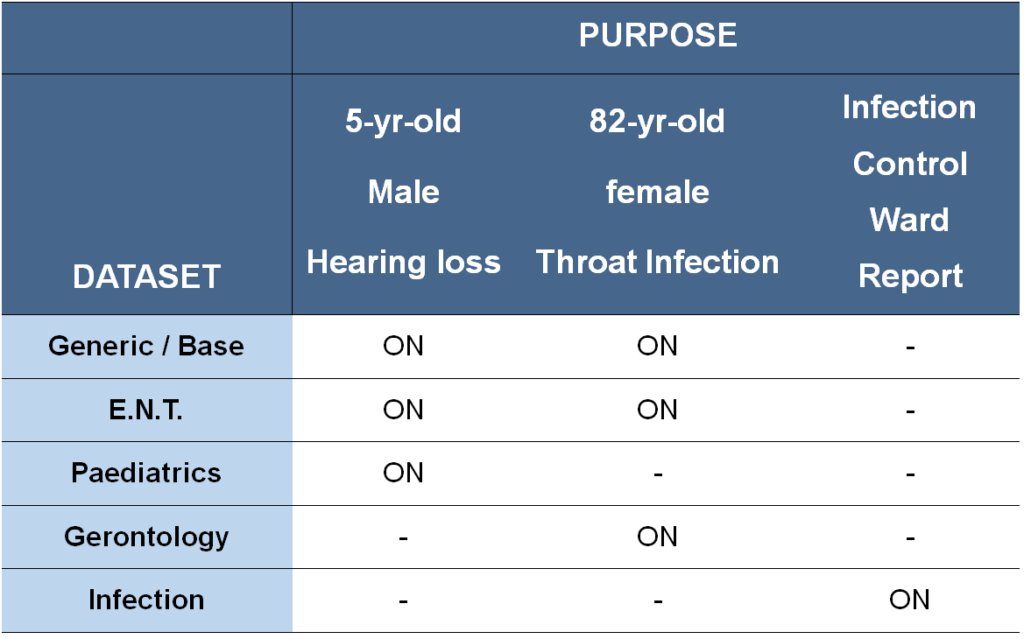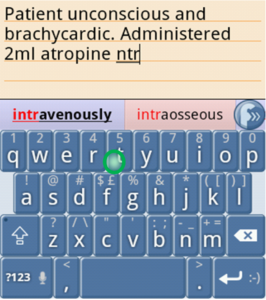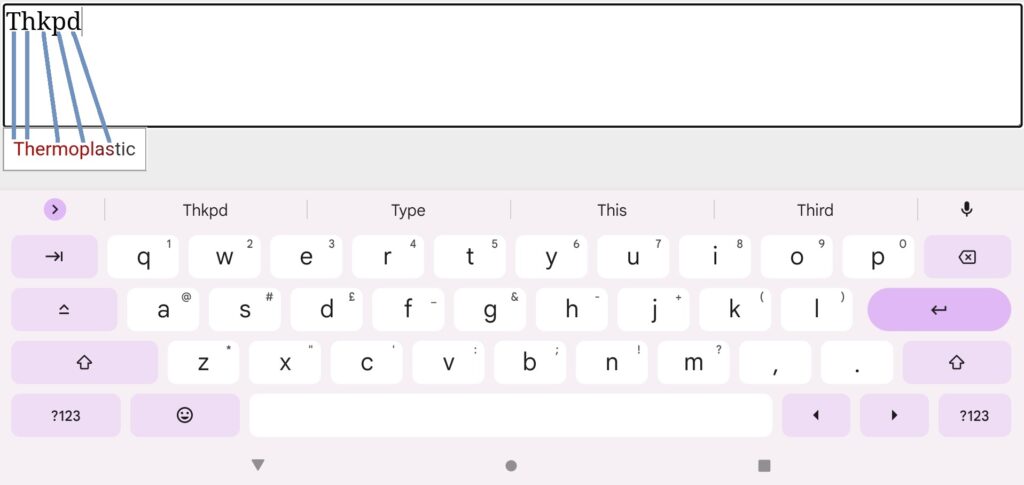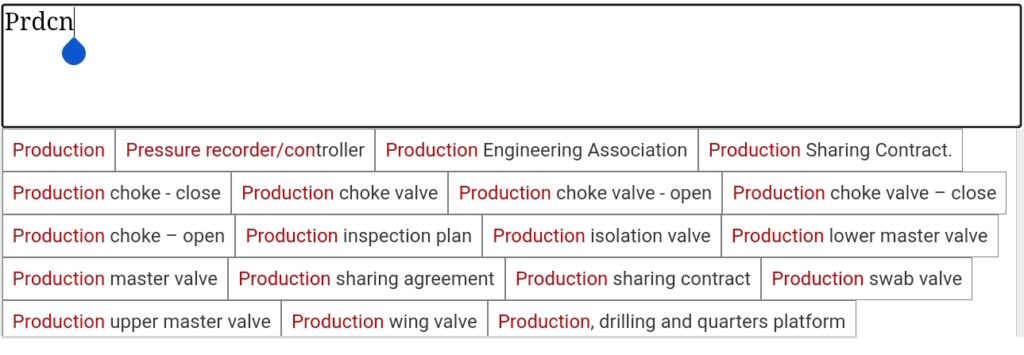FAQ
Most frequent questions and answers
Product Overview
Flexible Text Expansion:
Easily double your typing speed on a touchscreen, often faster (depending on complexity). Save time and money by creating text more quickly, easily and accurately.
● Transform form-filling, because you can define the exact words and phrases offered in each data-input field – e.g. in one, location names; in the next, complex technical terminology; then free text entry.
● Reduce time wasted on repetitive, standard documents, by automating large amounts of your work.
● Search box or chatbot input can be sped up considerably.
● No more typos as long, complicated and easily-misspelt phrases are offered within a few keystrokes. Subsequently, every instance of a word or phrase can be located again as it will be correctly spelt.
● Standardisation across company documents is enhanced by detecting alternatives while they are still being typed, and offering – without imposing – preferred terminology. This also makes it easier to search and translate documents.
● Further languages can be added relatively easily. (Currently in English (UK & US) and German, with French, Spanish and Chinese betas. Accents e.g. ‘é’, ‘è’, ‘ê’ etc. are added automatically as needed.)
● Each user’s personal language patterns move with them between devices.
In any webpage, plugged into your apps, or across the entire Operating System (Android/Windows).
Depending on what type of website you have, it can be added as a plugin for WordPress, or a standalone app in a directory.
It can work either on your server, or locally on the device itself.
It can also replace your input system in Android or Windows (with or without a physical keyboard)
AI
There has been a huge leap forward in the performance of AI / Chatbot products recently, with releases by many of the software giants, including Microsoft CoPilot, Google Gemini, ChatGPT by OpenAI etc.
These powerful new productivity solutions definitely, persuasively demonstrate a need and demand for faster interaction with our devices and applications. They can potentially be phenomenally useful. However, there are plenty of situations where they aren’t the right tool for the job, and where only direct input from a human will work.
Flexpansion is a context-specific text input acceleration tool. It is for scenarios where you are actually entering new information in a live situation, for instance a Health & Safety report, a medical consultation, a site inspection etc. AI may be useful for generating an initial document based on previous ones, but it will not be a live representation of the new information you are recording. It will probably contain, and be missing, large sections of irrelevant / necessary text. If you are using Generative AI, Flexpansion can help you edit and update this to capture the actual, current status.
Flexpansion is unique in its degree of customisability, and the ways it can be integrated into other products.
We see a lot of potential in gathering relevant training data for Flexpansion however, to improve prediction. For instance, given a small set of example documents, an AI can retrieve a larger dataset of similar language, including words and phrases that are appropriate but were missing.
Flexpansion is also likely to be dramatically more cost-effective than solutions from vast corporations. Microsoft acquired Word Prediction company SwiftKey in 2016 for $250m. They will require a Return On Investment on this acquisition and the salaries of its 100+ PhDs. Because we have built everything as a small, lean company, we don’t have their massive overheads. This allows us to offer a far more affordable, adaptive and customisable solution.
Finally, a note of caution: There is a lot of hype around AI currently, and how it will change the world. It will, but not necessarily as fast as its more enthusiastic proponents would have us believe. We have seen the dotcom boom and bust, the sudden crashes and scandals in cryptocurrency, and the repeated promise of mass adoption of self-driving cars. Even the Chief Operating Officer of OpenAI has warned in a December 2023 interview that AI for business is overhyped. He stated that the technology is still in its experimental infancy and will not change businesses quickly.
We will be monitoring developments closely to see how we might potentially integrate with AI systems.
These are predominantly agents / assistants, that perform all sorts of tasks such as researching and writing reports, summarising meetings from their minutes, planning events, and creating emails. (Plus lots of other things like creating pictures).
You ask questions and give instructions in natural language, and they use data from your previous documents for context.
Flexpansion isn’t a chatbot, it is a text input system.
Although CoPilot offers word prediction too, it is far less customisable, and can only work in an Microsoft 365 / Windows environment, locally to the machine it is on. Flexpansion will work cross-platform. A website or app with Flexpansion functionality offers word prediction to all visitors, regardless of which platform they are using.
Data Protection is another potential issue with huge AIs / Chatbots. Flexpansion ensures your data never leaves your control.
It differs in the level of complexity and customisability. Windows 10 offers one or two words at a time.
You can open up the settings completely in Flexpansion and edit everything, for instance:
- the relative weightings of elements like correction vs. completion
- how much to promote recently-used items
- how long suggested phrases should be
- a minimum probability for a suggestion to be displayed
- add and remove words and phrases
- the User Interface (grid of suggestions) etc.
It can also be integrated anywhere you want, such as in your web pages for other people to use, or plugged into your own apps. Whereas the solutions offered by large corporations will be mostly limited to their own ecosystems.
Furthermore, AI still appears to be using one, huge, collated language dataset, however quickly it may (or may not) be able to focus in on a topic.
Integration with webpages, apps etc.
Really easily. We’ll support you.
In 3 simple steps:
1) Train : Upload a dataset of specialist writing – from a basic text file to a folder of mixed documents, emails etc. – to the cloud, or locally on a device to ensure the data stays there unless intentionally shared.
2) Tune : Choose options such as:
- include general language prediction, or offer specialist terminology only
- autocorrection on/off
- abbreviation expansion on/off
- a maximum number of words allowed in a suggested phrase
- colours, sizes etc.
3) Embed : In a webpage with a few lines of JavaScript, or elsewhere using our API.
The engine is written in C++, and has complete APIs for C++ and Java.
The web interface is (currently) a stripped-down version in JavaScript.
More on Functionality
Like a standard word prediction system, only better.
Suggestions appear beneath the text box as you type, updating with each keystroke. Either keep typing, or tap to insert.
Personal profiles can be created for users, and carried between their devices. They can have multiple ones, such as personal, and different work scenarios.
Personalise set of suggestions displayed
Flexpansion can generate many possible suggestions, and display them ordered by probability. To reduce your search time however, it caps the number displayed, to a balance of the user’s choice of criteria:
● Frequency of use in that context
● Number of keystrokes saved, if it is selected (can justify displaying rarer items)
● A minimum probability
● A maximum number of suggestions
● A maximum total of characters, between the suggestions combined
● Only phrases up to a limited size
● Only phrases above a limited size
Ordering of suggestions
Highest-probability suggestions can be ordered from the top, (nearest the text box), or bottom, (nearest the keyboard).
User Interface
The browser display is fully customisable, including:
● Font (name, size, colours etc.)
● Grid & text box dimensions, line thickness etc.
● Layout, fixed-width cells, text justification etc.
● Display partial suggestions for refinement
● Condensed suggestions – Keywords open submenus of variations
These are datasets of word and phrase frequencies, and other patterns learned from your data. Flexpansion predicts using them, combined and ranked to your needs:
1) Base language – ordinary words and patterns e.g. UK English, German etc.
Can be ON or OFF.
2) Specialist – one or more, trained on your data
Your dataset is updated with every new keystroke and choice. (Demos currently reset after use).
Dashboard
Modules can be created, edited, shared, promoted/demoted, merged, combined etc. here.
Example Use Case
A doctor may write notes on a series of patients, with some shared terminology. They can customise prediction for each, saving the individual’s settings for later:

Flexpansion can adjust to situations where typing is difficult, for instance a moving vehicle or platform, or wearing gloves, or due to a disability. A slider adjusts the relative weightings between corrected words and abbreviation-expanded/autocompleted ones.
In our app version, you can adjust the size of your fingertip ‘footprint’ where it overlaps other keys, allowing correction to words that match nearby. You can also adjust the “decay” rate from the centre. Similar functionality can be added to the browser version.
The app furthermore takes into account where on a key it has been pressed, i.e. centrally or nearer to a neighbouring set. This cannot be done on the browser version, but could if our keyboard is installed across the entire device.
In the illustrations below:
- With High Precision, abbreviation works well as there is low ambiguity
- With Low Precision, you will need to type more letters, as there will be many more potential matches.
High Precision. Low Precision.
(& Abbreviation) Very forgiving of error


Extended Search
Where both Autocorrection and Abbreviation Expansion are enabled, each suggestion is either one or the other. We can offer both at once. In ‘normal’ text, this gives too many matches, but can be very powerful in smaller vocabularies with long, difficult words, such as medicine names.
In the example below, the letters ‘t’, ‘h’ and ‘p’ match the suggestion, and the letters ‘k’ and ‘d’ are corrected.

Highlighted Text-matched-so-far
Partnering / Licensing
Get in touch, and we will sort out an initial trial, and take it from there.
Setup & training fees, then ongoing per-user licences, updates and support. We are happy to White Label.
Very. Flexpansion can work online, or locally on each device. Language data never leaves unless explicitly exported, when it is encrypted.
We are happy for partners to inspect our code under NDA.
The Company - Flexpansion Ltd
We are based in Edinburgh, Scotland, UK
We own all our IP, which has been created by Edinburgh University graduates and PhDs. A patent is ready to submit. We are happy for all IP to be stored in escrow for your peace of mind.
The product is based on our founder’s PhD and MSc in Informatics (Information processing systems, specialising in AI and Computational Linguistics), which focused on enhancing communication for people with motor disabilities.
Anything else?
Thanks for visiting.

